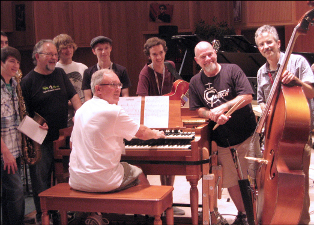I hadn't planned on writing here about my experience at the Jamey Aebersold Jazz Camp held at the University of Louisville in Kentucky in the second week of July, but it's so easy to summarize the key lessons I learned about soloing that I thought I'd jot them down after all:

The best way to get to where the music in your head comes out of your fingers as you think of it is to is to record yourself singing a solo along with a given chord progression (a.k.a. scat singing), transcribe what you wrote onto music paper, learn it on your instrument, and then repeat.
Get more comfortable with the bebop scales. These are common scales with an extra note added so that if you play a long string of eighth notes and include that extra note as you go up and down the scale, you're more likely to hit a chord tone on each downbeat. As the name implies, the technique was developed by the main musicians of the early bebop era.
Memorize the melodies of classic bebop tunes, especially the parts over the ii-V-I chord sequences (or even just the ii-V parts) so that you can use those licks over other ii-V-I chord sequences as they come up. They come up a lot.
Of course none of these are magic wands, but instead guidelines to productive ways to spend your practice time, and I have a lot of practicing to do. Bass players spend a lot of time practicing things to play behind the solos of other players, and my attempts at solos don't measure up to what the horn, piano, and guitar players that I play with are doing. I think I have a better idea how to catch up now.
The camp is like an intensive week of music school, where you start each day with a theory class, and then have master classes with others who play your instrument, rehearsals with the combo you've been assigned to, and more classes. Placement in a theory class and combo depend on a written test and audition you do upon arrival. The faculty has great and important players on each instrument, and each evening ended with a concert over two hours long of various groups of faculty members.
Each combo has a faculty member assigned to oversee them. I was happy that mine had trumpet player Pat Harbison, because as a horn player he put together some cool background harmonies for the group's horn section to play behind the vocals and non-horn solos. I've put pictures of Pat's combo on flickr and a recording of our recital on my MySpace page.
The attendees are an interesting mix—this year roughly half of the 300 or so people were under 21. The picture of our combo is pretty representative (unfortunately, our singer is not in that picture, but you can see her in the flickr pictures). You don't see many people in their twenties or thirties, because it's mostly teenagers and those of us closer to middle-age. Staying in a dorm was a bit of a pain, but cost a lot less than a hotel. My roommate was an alto player from Puerto Rico who is tired of playing salsa, and he's played with some big names such as El Gran Combo. (He only played with them as a sub; apparently, to get a full-time position, you have to wait for someone who plays your instrument in the band to die.) I had heard of El Gran Combo before, but never listened to them much, and have been doing so on GrooveShark, my new favorite music site. I highly recommend them.
On the last day, recital day, the 30 or so combos each play one song in one of two recital halls. It was fun to go back and forth and see different combinations of young and old attendees that I'd met during the week.
During the eight-hour drive back, I noticed that if you go south from the 70 miles of I-64 between Louisville and Lexington, many major bourbon distilleries are grouped together there. At first I thought this was an interesting coincidence, but then I remembered that bourbon is named for the Kentucky county where distillers first started to age their corn liquor in charred oak casks, and I was there (more or less—the boundaries have changed over the years). In the nineteenth century, drinkers down the river in New Orleans liked it so much more than the unaged corn whiskey from other places that they started requesting the Bourbon whiskey. I learned a lot more during my tour of the Wild Turkey distillery, but skipped the free samples at the end of the tour because of the seven hours of driving I still had ahead of me. It was still nice to get my mind off of scales and chords.


I can't believe you couldn't do the tasting at the distilleries! Probably wouldn't be worth the extra hotel night so I'm glad your birthday present was waiting at home for you. Not one mention of what you ate, not very DuCharme of you.
i remember working w/ Aebersold audio cassette tapes *years* ago; i even think i had a few of his LPs to practice against!
brings back fond memories.
At one point during the week I suggested that a turntablist with one of these LPs would make an excellent addition to a recital combo, although I'm sure it would have given Mr. Aebersold a heart attack.
Lots of French in this: Louisville, Bourbon, Orleans, and of course du Charme.
What instrument do you play?
I play bass. Next week I'll be at:
http://www.stanfordjazz.org/education/jazzresidency.html